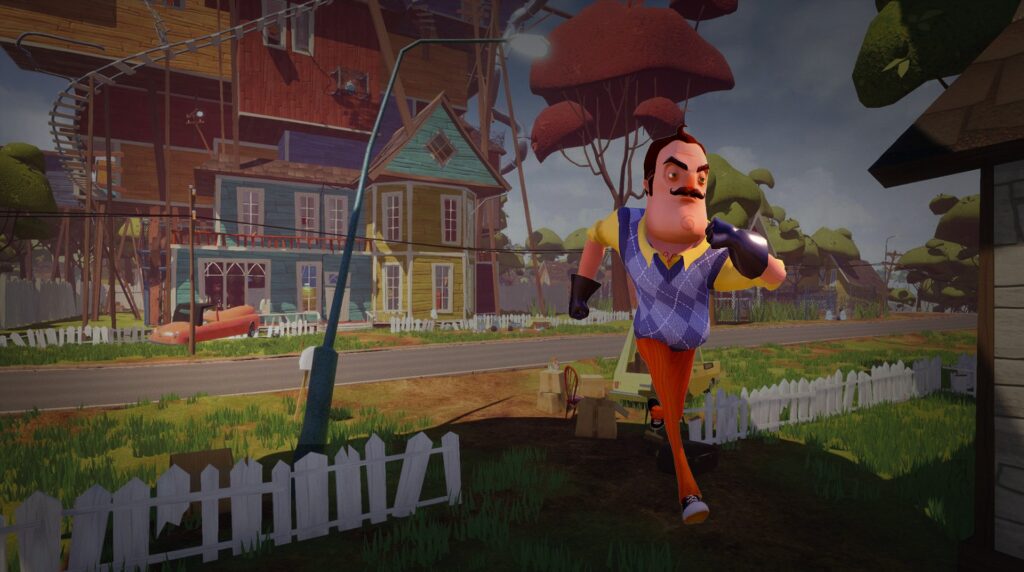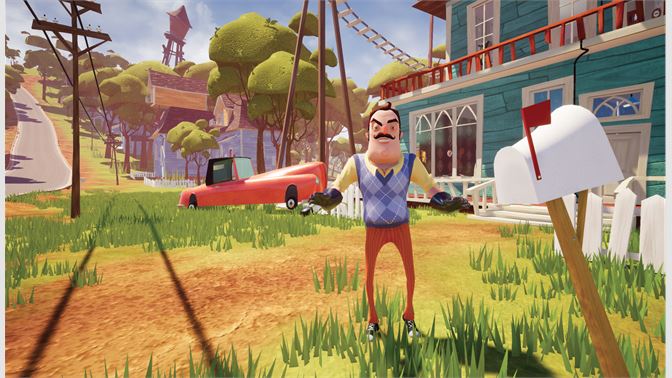Popular Now
Hello Neighbor stands out in the stealth horror genre, largely thanks to its unique enemy AI. Unlike traditional horror antagonists that follow fixed patrol routes, the Neighbor evolves and adapts to the player's actions over time. This learning AI mechanic defines the tension and unpredictability at the heart of the game. In this article, we will explore how AI learning shapes the Neighbor's behavior, impacts gameplay progression, and creates a dynamic horror experience.
Understanding the Concept of Adaptive AI in Hello Neighbor
At the beginning of Hello Neighbor, players might notice that the Neighbor follows simple routines. Initially, he patrols certain parts of his house or performs predictable tasks like watering plants. However, after a few failed break-in attempts, players quickly realize that the Neighbor adapts.

Basic AI Behavior at Game Start
During the first few encounters, the Neighbor relies on static behavior scripts. He walks in set paths and rarely reacts unless directly provoked. This lulls new players into a false sense of security.
Triggered Responses
Once the player enters forbidden zones, the AI triggers chase responses. This first layer of learning sets the foundation for more complex behaviors that emerge later.

Tracking Player Movements and Strategies
One of the most fascinating aspects of the Neighbor's AI is its ability to track the player's common entry points and routes.
Learning Frequent Entry Points
If a player repeatedly breaks in through the front window, the Neighbor soon places bear traps or security cameras there. This forces players to change strategies and find new entry points.
Blocking Access Paths
Beyond traps, the Neighbor starts boarding up frequently used windows or locking doors. This environmental change shows direct evidence of the AI's learning algorithm adapting to the player.

How the AI Uses Environmental Traps
As the game progresses, the Neighbor begins using the environment more aggressively to control the player's movement.
Increased Trap Deployment
If a player frequently uses the kitchen door, the AI places glue puddles or more bear traps in that area. This makes previously safe paths suddenly dangerous.
Camera Installation and Monitoring
In higher difficulty stages, the Neighbor installs more surveillance cameras around commonly accessed zones. These cameras feed directly into his awareness system, making stealth significantly harder.
Learning Player Timing Patterns
Another critical layer of AI learning revolves around time-based prediction of player behavior.
Anticipating Routine Actions
If players prefer sneaking in during daytime cycles, the Neighbor will start patrolling more aggressively during those times. This change forces players to reconsider their timing.

Predicting Repeat Offenses
When the AI notices patterns in player timing, it proactively adjusts schedules, making the Neighbor appear earlier or linger longer in certain rooms.
Dynamic Chasing and Combat Behavior
Chase sequences become increasingly difficult as the Neighbor adjusts his pursuit tactics based on past encounters.
Shortening Reaction Time
After several failed captures, the Neighbor begins reacting faster to sounds and movements. His detection radius also expands, making it more challenging to sneak.
Improved Pathfinding
The AI enhances its chase routes, using shortcuts or predicting escape paths the player often uses. This makes outrunning the Neighbor far more difficult as the game progresses.

Adapting to In-Game Tools Used by Players
Players often rely on tools like boxes, flashlights, or thrown objects to distract the Neighbor. However, the AI adapts to these tactics too.
Countering Distraction Tactics
If the player uses thrown objects to lure the Neighbor away multiple times, the AI will stop falling for the same trick as easily.
Reinforcing Vulnerable Areas
The Neighbor reinforces and heavily guards locations where players repeatedly use distraction strategies, making stealth much more demanding.
Memory Reset and How the AI Clears Old Patterns
Although the AI learns rapidly, it doesn’t hold memories indefinitely. The system uses a memory decay model to prevent unfair gameplay scenarios.
Natural Memory Fade
Over time, the Neighbor forgets older player behavior patterns, especially if the player changes tactics. This creates windows of opportunity to reuse old strategies.
Forcing AI Reset
Game design includes mechanisms where specific player actions can force the AI to reprioritize, effectively resetting some learned behaviors. This adds another layer of strategic planning for players.
Player Psychology and How AI Learning Manipulates Fear
Beyond mechanics, the AI also manipulates player psychology, using unpredictability as a fear factor.
Creating Uncertainty
When players realize the AI learns and reacts, every step feels risky. Even if an area was safe before, the chance that the AI has set a new trap adds mental pressure.
Triggering Panic Behavior
The Neighbor sometimes feigns ignorance or delays his reaction intentionally. This behavior lures players into a false sense of security before sudden chases begin.
Limitations and Exploitable Weaknesses in the AI
Despite its strengths, the Neighbor's AI still contains exploitable flaws that advanced players can manipulate.

AI Pathfinding Bugs
Occasionally, the AI struggles with complex pathfinding in multi-story environments, giving players a small tactical advantage.
Overreaction Patterns
If players create chaotic distractions across multiple zones simultaneously, the AI sometimes becomes confused and less effective in its response.
The Evolution of AI Learning in Hello Neighbor Sequels
With each new installment and update, Hello Neighbor's AI learning systems have become more advanced.
Improved Machine Learning Models
Later games like Hello Neighbor 2 introduced more sophisticated AI models, enabling the Neighbor to process wider player behavior patterns and use environmental tools more intelligently.
Community Feedback and AI Tweaks
TinyBuild continues refining AI responses based on community feedback. Many updates directly address overly predictable patterns or bugs within the learning system.
Conclusion
Hello Neighbor’s AI learning system remains one of its most innovative and defining features. From tracking player movements to deploying environmental traps, adjusting chase tactics, and manipulating player psychology, the Neighbor’s adaptive behavior makes every gameplay session unique. Although the AI has limitations, its evolving nature creates a suspenseful and dynamic horror experience that keeps players engaged and on edge. Understanding how this AI works not only helps players survive but also deepens appreciation for Hello Neighbor’s design complexity.

















